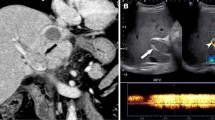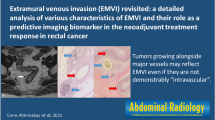Abstract
The purpose of this article is to describe and demonstrate the appearances of extramural vascular invasion on computed tomography in gastrointestinal malignancies as one of the pathways of disease spread. In this article, we demonstrate the imaging features with pathologically proven examples, along with a brief description of relevant vascular anatomy. We shall also discuss the clinical significance and prognostic implications of extramural vascular invasion in gastrointestinal malignancies.














Similar content being viewed by others
References
Meyers MA, McSweeney J (1972) Secondary neoplasms of the bowel. Radiology 105(1):1–11
Meyers MA, Oliphant M, Berne AS, Feldberg MA (1987) The peritoneal ligaments and mesenteries: pathways of intraabdominal spread of disease. Radiology 163(3):593–604
Oliphant M, Berne AS, Meyers MA (1993) Spread of disease via the subperitoneal space: the small bowel mesentery. Abdom Imaging 18(2):109–116
Oliphant M, Berne AS, Meyers MA (1993) Bidirectional spread of disease via the subperitoneal space: the lower abdomen and left pelvis. Abdom Imaging 18(2):117–125
Charnsangavej C, Dubrow RA, Varma DG, et al. (1993) Ct of the mesocolon. Part 2: pathologic considerations. Radiographics 13(6):1309–1322
Chou CK, Liu GC, Chen LT, Jaw TS (1993) MRI demonstration of peritoneal ligaments and mesenteries. Abdom Imaging 18(2):126–130
Meyers MA (1973) Distribution of intra-abdominal malignant seeding: dependency on dynamics of flow of ascitic fluid. Am J Roentgenol Radium Ther Nucl Med 119(1):198–206
Chou CK, Liu GC, Su JH, et al. (1994) MRI demonstration of peritoneal implants. Abdom Imaging 19(2):95–101
Low RN (2007) MR imaging of the peritoneal spread of malignancy. Abdom Imaging 32(3):267–283. doi:10.1007/s00261-007-9210-8
De Gaetano AM, Calcagni ML, Rufini V, et al. (2009) Imaging of peritoneal carcinomatosis with FDG PET-CT: diagnostic patterns, case examples and pitfalls. Abdom Imaging 34(3):391–402. doi:10.1007/s00261-008-9405-7
McDaniel KP, Charnsangavej C, DuBrow RA, et al. (1993) Pathways of nodal metastasis in carcinomas of the cecum, ascending colon, and transverse colon: CT demonstration. AJR Am J Roentgenol 161(1):61–64
Granfield CA, Charnsangavej C, Dubrow RA, et al. (1992) Regional lymph node metastases in carcinoma of the left side of the colon and rectum: CT demonstration. AJR Am J Roentgenol 159(4):757–761
Gabbert HE, Meier S, Gerharz CD, Hommel G (1991) Incidence and prognostic significance of vascular invasion in 529 gastric-cancer patients. Int J Cancer 49(2):203–207
Minsky BD, Cohen AM (1999) Blood vessel invasion in colorectal cancer—an alternative to TNM staging? Ann Surg Oncol 6(2):129–130
Gastrointestinal tract (2008) Section 8: Abdomen and pelvis. In: Standring S (ed) Gray’s anatomy, 40th edn. Elsevier, Churchill Livingstone, pp 1111–1137
Sternberg A, Amar M, Alfici R, Groisman G (2002) Conclusions from a study of venous invasion in stage IV colorectal adenocarcinoma. J Clin Pathol 55(1):17–21
Gastric cancer treatment (stage information for gastric cancer) (2009) National Cancer Institute. http://www.cancer.gov/cancertopics/pdq/treatment/gastric/HealthProfessional/page4. Accessed 22 Feb 2009
Inada K, Shimokawa K, Ikeda T, Ozeki Y (1990) The clinical significance of venous invasion in cancer of the stomach. Jpn J Surg 20(5):545–552
Tang W, Nakamura Y, Tsujimoto M, et al. (2002) Heparanase: a key enzyme in invasion and metastasis of gastric carcinoma. Mod Pathol 15(6):593–598. doi:10.1038/modpathol.3880571
Zheng HC, Li XH, Hara T, et al. (2008) Mixed-type gastric carcinomas exhibit more aggressive features and indicate the histogenesis of carcinomas. Virchows Arch 452(5):525–534. doi:10.1007/s00428-007-0572-7
Shiraishi N, Inomata M, Osawa N, Yasuda K, Adachi Y, Kitano S (2000) Early and late recurrence after gastrectomy for gastric carcinoma. Univariate and multivariate analyses. Cancer 89 (2):255–261. doi:10.1002/1097-0142(20000715)89:2<255::AID-CNCR8>3.0.CO;2-N
del Casar JM, Corte MD, Alvarez A, et al. (2008) Lymphatic and/or blood vessel invasion in gastric cancer: relationship with clinicopathological parameters, biological factors and prognostic significance. J Cancer Res Clin Oncol 134(2):153–161. doi:10.1007/s00432-007-0264-3
Kim JH, Park SS, Park SH, et al. (2010) Clinical significance of immunohistochemically-identified lymphatic and/or blood vessel tumor invasion in gastric cancer. J Surg Res 162(2):177–183. doi:10.1016/j.jss.2009.07.015
Kim HJ, Kim AY, Oh ST, et al. (2005) Gastric cancer staging at multi-detector row CT gastrography: comparison of transverse and volumetric ct scanning. Radiology 236(3):879–885. doi:10.1148/radiol.2363041101
Liebig C, Ayala G, Wilks JA, Berger DH, Albo D (2009) Perineural invasion in cancer: a review of the literature. Cancer 115(15):3379–3391. doi:10.1002/cncr.24396
Cancer facts and figures (2010) American Cancer Society. http://www.cancer.org/acs/groups/content/@nho/documents/document/acspc-024113.pdf. Accessed 14 Sep 2010
Phan AT, Yao JC (2008) Neuroendocrine tumors: Novel approaches in the age of targeted therapy. Oncology (Williston Park) 22(14):1617–1623; discussion 1623–1614, 1629
Bilimoria KY, Bentrem DJ, Wayne JD, et al. (2009) Small bowel cancer in the United States: changes in epidemiology, treatment, and survival over the last 20 years. Ann Surg 249(1):63–71. doi:10.1097/SLA.0b013e31818e4641
Yao JC, Hassan M, Phan A, et al. (2008) One hundred years after “Carcinoid”: epidemiology of and prognostic factors for neuroendocrine tumors in 35, 825 cases in the United States. J Clin Oncol 26(18):3063–3072. doi:10.1200/JCO.2007.15.4377
Levy AD, Sobin LH (2007) From the archives of the AFIPp: gastrointestinal carcinoids: imaging features with clinicopathologic comparison. Radiographics 27(1):237–257. doi:10.1148/rg.271065169
Solcia E, Kloppel G, Sobin LH (2000) WHO international histological classification of tumors, 2nd edn. Berlin: Springer
Boudreaux JP, Putty B, Frey DJ, et al. (2005) Surgical treatment of advanced-stage carcinoid tumors: lessons learned. Ann Surg 241(6):839–845 (discussion 845–836)
Landry CS, Brock G, Scoggins CR, McMasters KM, Martin RC 2nd (2008) A proposed staging system for small bowel carcinoid tumors based on an analysis of 6,380 patients. Am J Surg 196(6):896–903 (discussion 903). doi:10.1016/j.amjsurg.2008.07.042
Brown CE, Warren S (1938) Visceral metastases from rectal carcinoma. Surg Gynecol Obstet 66:611–621
Suzuki A, Togashi K, Nokubi M, et al. (2009) Evaluation of venous invasion by elastica van gieson stain and tumor budding predicts local and distant metastases in patients with T1 stage colorectal cancer. Am J Surg Pathol 33(11):1601–1607. doi:10.1097/PAS.0b013e3181ae29d6
Talbot IC, Ritchie S, Leighton MH, et al. (1980) The clinical significance of invasion of veins by rectal cancer. Br J Surg 67(6):439–442
Adachi Y, Inomata M, Kakisako K, et al. (1999) Histopathologic characteristics of colorectal cancer with liver metastasis. Dis Colon Rectum 42(8):1053–1056
Horn A, Dahl O, Morild I (1991) Venous and neural invasion as predictors of recurrence in rectal adenocarcinoma. Dis Colon Rectum 34(9):798–804
Smith NJ, Barbachano Y, Norman AR, et al. (2008) Prognostic significance of magnetic resonance imaging-detected extramural vascular invasion in rectal cancer. Br J Surg 95(2):229–236. doi:10.1002/bjs.5917
Smith NJ, Shihab O, Arnaout A, Swift RI, Brown G (2008) MRI for detection of extramural vascular invasion in rectal cancer. AJR Am J Roentgenol 191(5):1517–1522. doi:10.2214/AJR.08.1298
Author information
Authors and Affiliations
Corresponding author
Rights and permissions
About this article
Cite this article
Tan, C.H., Vikram, R., Boonsirikamchai, P. et al. Extramural venous invasion by gastrointestinal malignancies: CT appearances. Abdom Imaging 36, 491–502 (2011). https://doi.org/10.1007/s00261-010-9667-8
Published:
Issue Date:
DOI: https://doi.org/10.1007/s00261-010-9667-8




